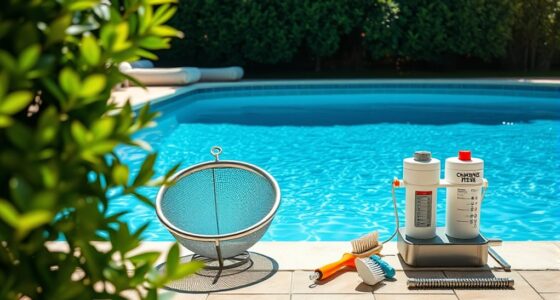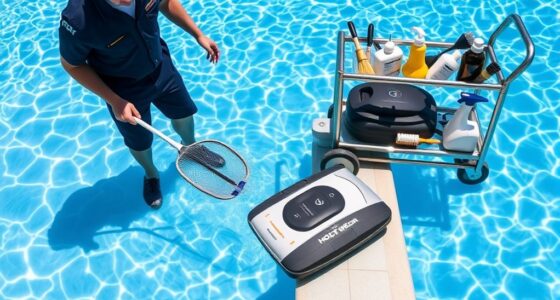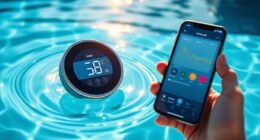To clean your pool easily, gather essential tools like a skimmer, vacuum, brush, and safety gear. Skim the surface daily to remove leaves and debris, then vacuum the pool bottom regularly to keep it spotless. Brush the walls and tiles to prevent algae buildup, and maintain proper water chemistry by testing and adjusting chemicals weekly. Don’t forget to clean or replace your filter often. Keep things simple with this routine, and you’ll stay on top of pool care effortlessly.
Key Takeaways
- Use a combination of surface skimming and brushing to remove debris and prevent algae buildup efficiently.
- Employ a pool vacuum or robotic cleaner regularly to keep the pool bottom spotless with minimal effort.
- Maintain proper water chemistry by testing and adjusting pH and chlorine levels weekly to prevent cloudiness and algae.
- Cover the pool daily when not in use to reduce dirt, debris, and evaporation, simplifying cleaning routines.
- Follow a routine maintenance schedule, including inspections and chemical adjustments, to ensure consistently clean and safe water.
Gather the Right Cleaning Tools and Supplies
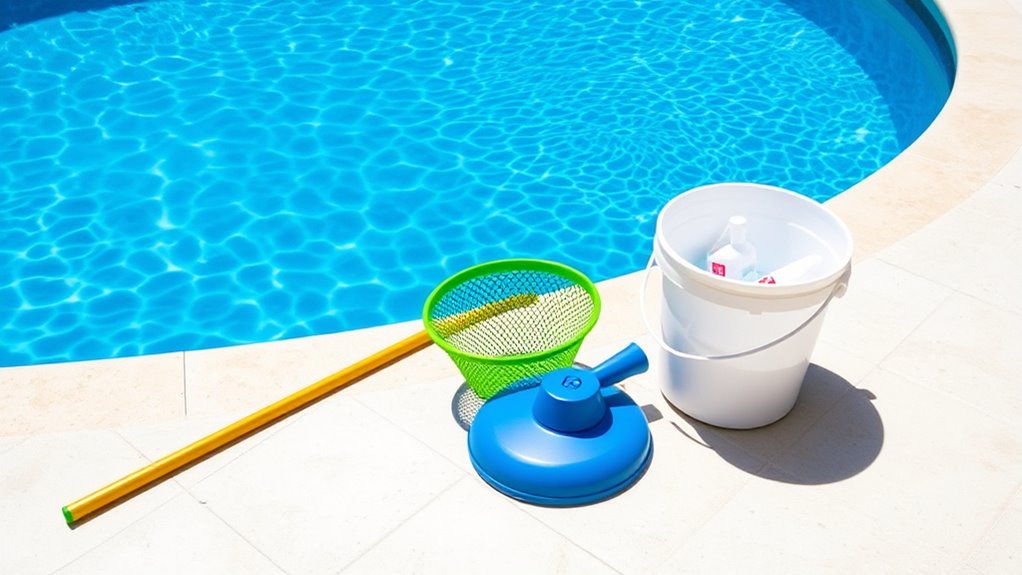
Before you begin cleaning your pool, it is vital to gather all the necessary tools and supplies. Making sure you have the right equipment promotes pool safety and makes the process more energy-efficient. Start with a sturdy pool skimmer to remove surface debris, and a telescopic pole to reach hard spots. A pool vacuum helps clean the bottom thoroughly, saving energy by reducing the need for excessive filtration. Don’t forget a brush for walls and tiles to prevent buildup, which can impact water flow and energy use. Safety gear like gloves and goggles protect you during cleaning. Using quality tools minimizes the effort needed, keeps your pool in top shape, and reduces electricity consumption. Being prepared with proper supplies ensures a safer, more efficient cleaning process. Additionally, choosing appropriate cleaning tools can significantly enhance effectiveness and protect your pool surfaces from damage.
Skim the Surface to Remove Debris
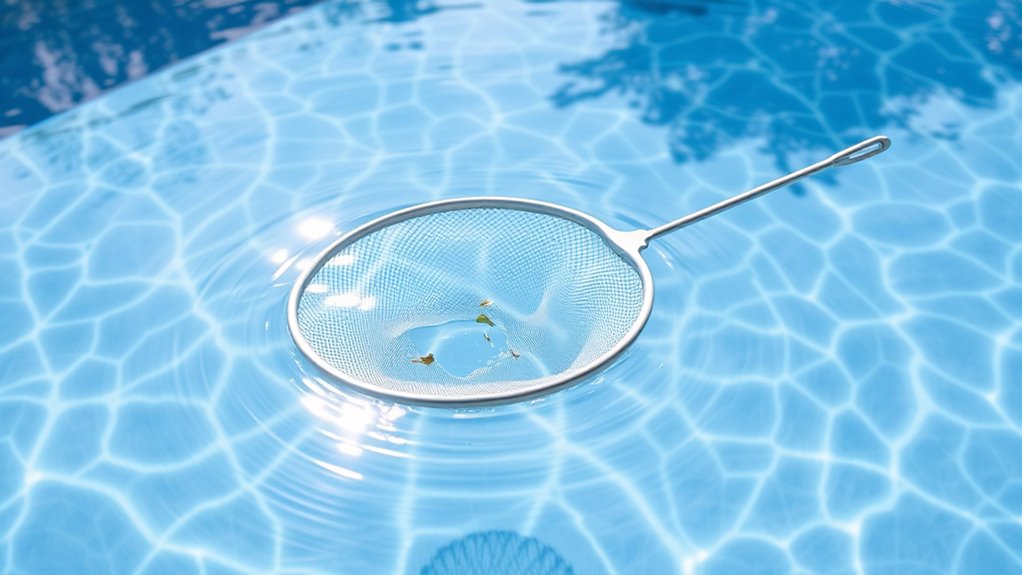
Have you ever noticed leaves, insects, or other debris floating on your pool’s surface? If so, it’s time for some surface skimming. Using a leaf removal net or skimmer, gently drag it across the surface to catch floating debris. Regular surface skimming prevents debris from sinking and helps keep your water clear. Focus on the areas where debris tends to accumulate, especially near the edges and corners. Make sure to remove leaves, insects, and twigs promptly to avoid them breaking down and clouding your water. Proper pool maintenance techniques include routine skimming as a foundational step for maintaining water clarity and quality. Surface skimming is quick and effective, and doing it daily during the swimming season keeps your pool looking inviting. Keep your pool debris-free with this simple step, and you’ll save time on more intensive cleaning later. Incorporating proper pool maintenance techniques can further ensure your water stays clean and balanced.
Vacuum the Pool Floor Effectively
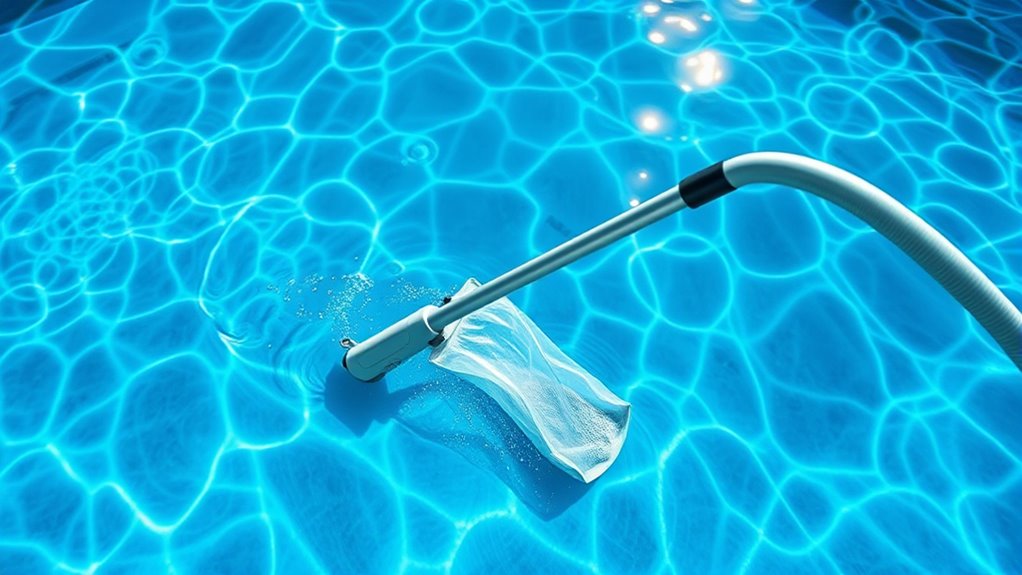
Vacuuming the pool floor is essential for maintaining a clean and healthy swimming environment. You can choose between robotic cleaners or manual vacuuming to remove dirt and debris effectively. Robotic cleaners are convenient; they navigate the pool automatically, saving you effort and time. Simply set them up and let them do the work. Manual vacuuming, on the other hand, requires attaching a hose and vacuum head to your pool’s skimmer or pump. Move the vacuum slowly across the floor to pick up dirt and sediment. Regular vacuuming prevents buildup, keeps your water clear, and prolongs the life of your pool equipment. Additionally, considering automatic cleaning technology can further streamline your maintenance routine. Whether you prefer the automation of robotic cleaners or the control of manual vacuuming, consistent cleaning makes your pool inviting and safe. For added efficiency, consider using effective cleaning tools that are recommended by pool maintenance experts.
Brush the Walls and Tiles to Prevent Algae Build-up
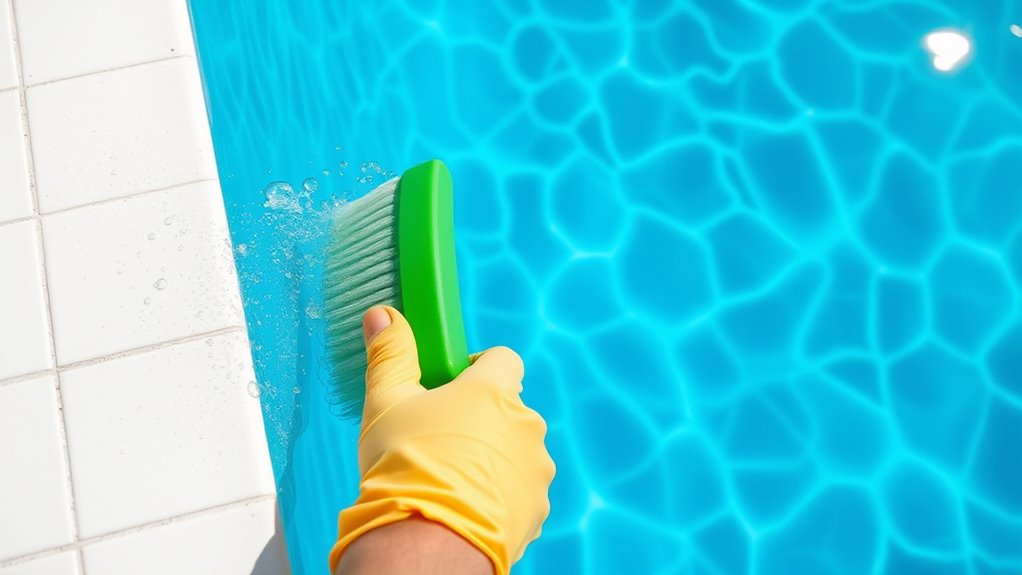
To keep algae from taking hold, regularly brushing the walls and tiles is essential. Consistent algae prevention relies on effective wall scrubbing techniques to disrupt algae spores before they grow. Use a stiff-bristle brush designed for pool surfaces, focusing on areas with rough textures or visible buildup. Start at the waterline and work downward, applying steady pressure to loosen algae and debris. Pay special attention to corners, steps, and around fittings where algae typically hide. Regular brushing prevents algae from establishing a foothold, reducing the need for chemical treatments later. Incorporating wall scrubbing techniques into your weekly maintenance routine helps maintain a clean and self-watering plant pots pool surface, promoting healthier water quality. Staying proactive ensures your pool remains inviting, clear, and easy to maintain. Additionally, understanding the importance of favorable water chemistry can further enhance your pool maintenance efforts.
Maintain the Water Chemistry for Clarity

You need to test your pool water regularly to keep it clear and safe. When tests show chemical levels are off, you should modify them promptly. Maintaining proper water chemistry ensures your pool stays inviting and healthy for swimmers. Additionally, understanding diversification strategies can help you choose the right products to maintain your pool efficiently.
Test Water Regularly
Regularly testing your pool water is essential to maintain proper chemistry and keep the water clear. Water testing helps you identify imbalances that could lead to cloudiness or algae growth. Use test kits or strips to check pH, chlorine, and alkalinity levels. Consistent testing ensures you can promptly address issues and maintain ideal chemical balancing. To understand the importance, consider this table:
| Test Parameter | Ideal Range | Consequence of Imbalance |
|---|---|---|
| pH | 7.2–7.6 | Cloudiness, skin irritation |
| Chlorine | 1–3 ppm | Bacteria, algae growth |
| Alkalinity | 80–120 ppm | pH swings, corrosion |
| Total Hardness | 200–400 ppm | Scaling or etching |
| Cyanuric Acid | 30–50 ppm | UV protection, disinfection |
Staying vigilant with water testing keeps your pool safe and sparkling. Proper testing can also prevent damage to your pool equipment and extend its lifespan. Additionally, understanding the water chemistry helps you make informed adjustments to maintain a healthy swimming environment.
Adjust Chemical Levels
Ever wonder how to keep your pool water crystal clear? Maintaining the water chemistry is key, and that starts with adjusting chemical levels. Start by testing the water regularly to check the pH and chlorine levels. If the pH is too high or low, perform a pH adjustment using appropriate chemicals to bring it into the ideal range of 7.2 to 7.6. Proper chemical balance prevents algae growth, cloudy water, and skin irritation. Add sanitizer if needed to boost chlorine levels and keep bacteria at bay. Always follow the manufacturer’s instructions when adding chemicals, and retest after each adjustment. Consistently monitoring and adjusting chemical levels guarantees your pool stays clean, clear, and inviting with minimal effort. Regular testing is essential for effective chemical management and maintaining water clarity. Additionally, understanding the importance of water chemistry helps prevent common issues like scale buildup and corrosion, making your pool maintenance more effective.
Regularly Clean and Replace the Filter

To keep your pool water clean and clear, it’s essential to regularly clean and replace the filter. Proper filter maintenance ensures maximum water circulation, preventing debris buildup that can cause cloudy water or algae growth. Neglecting this step can strain your pool’s pump and reduce filtration efficiency. Incorporating Mazda Tuning techniques can also help optimize your vehicle’s performance, similar to maintaining your pool for optimal clarity. Additionally, staying informed about data privacy challenges helps ensure your personal information remains secure during maintenance routines.
Establish a Simple Maintenance Routine

Creating a simple maintenance routine for your pool helps keep the water clean and reduces the risk of problems. Start by regularly inspecting your pool cover; it protects your water from debris and minimizes evaporation. When you remove the cover, check for dirt and debris, and clean it as needed to maintain pool safety. Set a weekly schedule to skim the surface, brush the walls, and vacuum the pool bottom. Test the water’s pH and chlorine levels, adjusting chemicals accordingly. Keep a record of maintenance tasks to stay consistent. Using a pool cover daily when not in use reduces dirt buildup and enhances safety. It is also beneficial to monitor the water’s water quality, ensuring that the chemical balance stays within safe ranges. Regular routine maintenance is essential for preventing algae growth and maintaining crystal-clear water. Establishing this routine makes pool care manageable, ensuring safe, clean water and prolonging your equipment’s lifespan.
Frequently Asked Questions
How Often Should I Perform a Full Pool Cleaning?
You should perform a full pool cleaning weekly to maintain proper pool maintenance and chemical balancing. Regular cleaning prevents algae buildup, debris accumulation, and water cloudiness. During this process, skim the surface, vacuum the floor, and brush the walls. Check and adjust chemicals to keep pH and chlorine levels balanced. Consistent cleaning guarantees your pool stays inviting, safe, and easy to manage, saving you time and effort in the long run.
Can I Use Household Cleaning Products on My Pool?
Think of your pool as a delicate garden that needs the right tools. Using household chemicals on your pool is like planting with the wrong seeds—dangerous and harmful. Household cleaning products often contain harsh chemicals that can upset your pool’s balance and pose cleaning safety risks. Instead, stick to pool-specific cleaners and check labels carefully. Protect your pool’s health and avoid damage by choosing products designed for safe, effective pool maintenance.
How Do I Remove Stubborn Algae From Tiles?
To remove stubborn algae from tiles, you need effective algae removal techniques and tile scrubbing. Start by brushing the tiles with a stiff brush to loosen algae buildup. Use a pool-safe algae remover or a mixture of vinegar and water for scrubbing. Let it sit for a few minutes, then scrub thoroughly. Rinse with clean water and repeat if necessary. Regular maintenance prevents algae from returning and keeps your pool tiles clean.
What’s the Best Time of Day to Clean My Pool?
Sure, because who wouldn’t want to clean their pool during the best morning or late afternoon, right? It’s actually the perfect time to avoid the scorching midday sun and the evening rush. Cleaning in the morning means fresh, clear water to start your day. Late afternoon cleaning helps you unwind after work, enjoying the cooler air. Either way, you get the job done without turning your pool into an unintended swamp.
How Can I Prevent Algae Growth Between Cleanings?
To prevent algae growth between cleanings, you should focus on good pool cover maintenance and routine chemical balance checks. Keep your pool covered when not in use to block sunlight and debris that promote algae. Regularly test and adjust your pool’s chemicals, especially chlorine and pH levels, to create an inhospitable environment for algae. These steps help keep your pool clear and reduce the frequency of deep cleaning sessions.
Conclusion
Now, picture yourself dipping your hand into crystal-clear water, feeling the coolness wash over you as your spotless pool sparkles under the sun. With your tools ready and routine in place, maintaining this serene oasis becomes effortless. Regular cleaning keeps algae at bay and water inviting. Soon, you’ll enjoy effortless swims and peaceful moments, relaxing as the shimmering surface reflects your dedication. Keep it simple, stay consistent, and your pool will always be a invigorating retreat.


